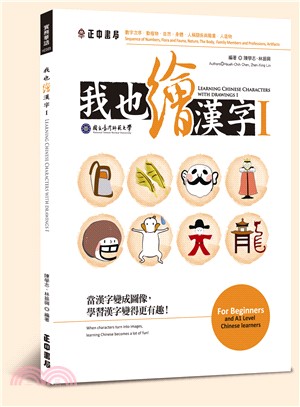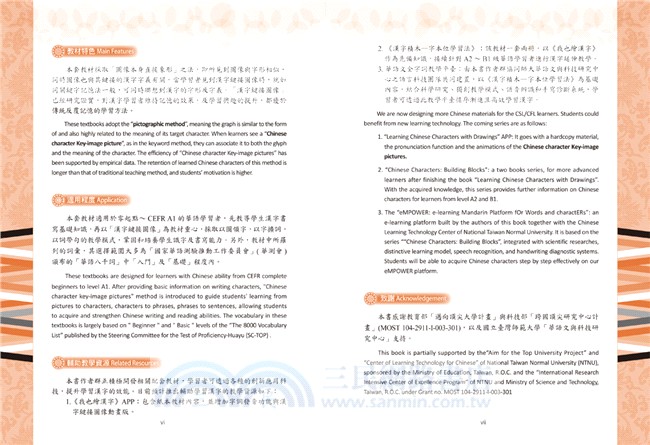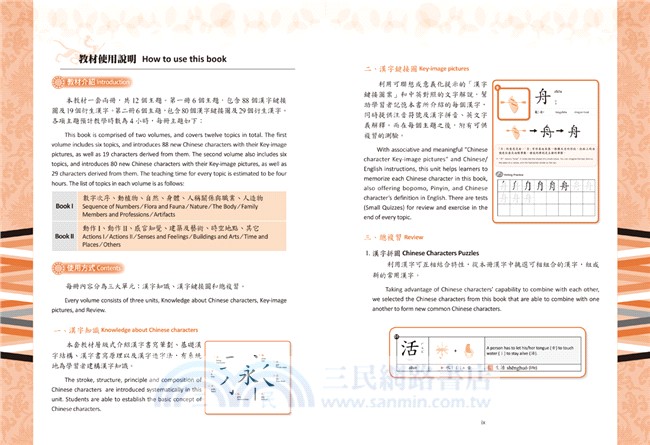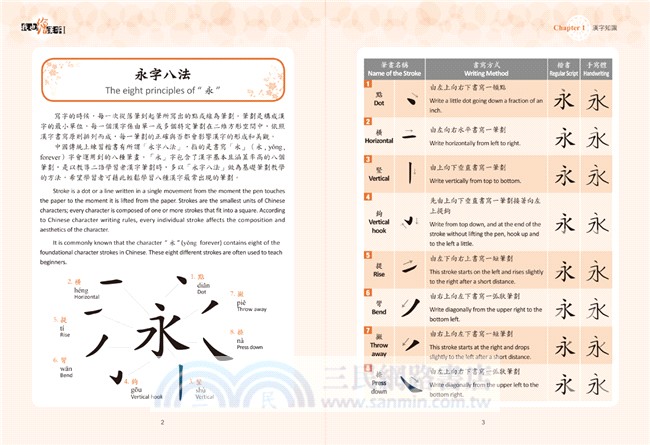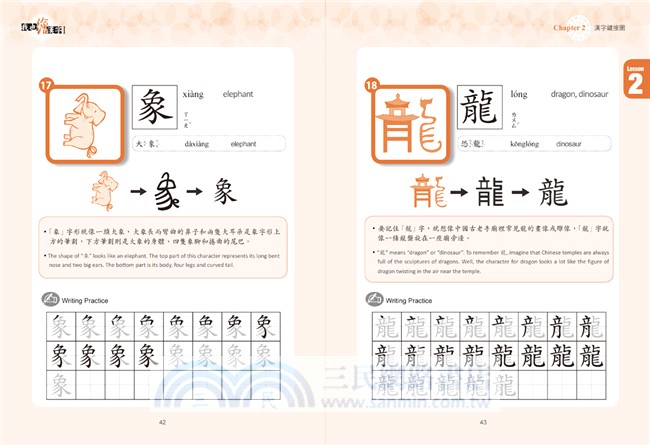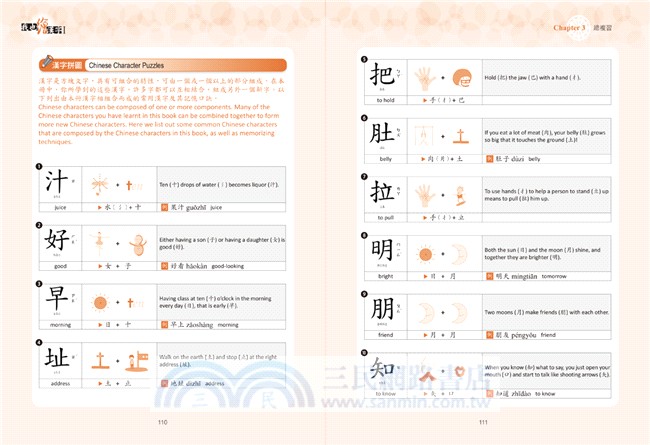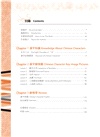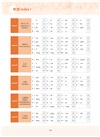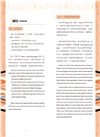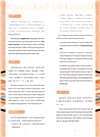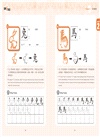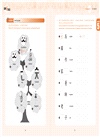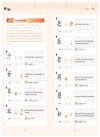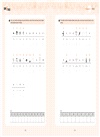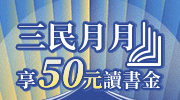商品簡介
本書由國立臺灣師範大學陳學志及林振興兩位教授共同編著,針對常用部首及漢字,基於認知學習原理,獨創了一套結合關鍵字記憶法及圖像聯想的「漢字鍵接圖像(Chinese Character Key-image Pictures)」而編寫出此套漢字教材,以協助學習者克服漢字記憶和書寫困難,奠定日後大量學習漢字的基礎。
|本書特色
‧系統式建構漢字學習基礎,幫助學習者大量記憶漢字。
‧何謂「漢字鍵接圖像(Chinese Character Key-image Pictures)」?
「漢字鍵接圖像(Chinese Character Key-image Pictures)」是介於漢字形和字義之間的一種圖像,讓學習者一看到圖像就能和漢字產生連結,幫助學習者快速記憶漢字。
當學習者見到漢字鍵接圖像時,就如同關鍵字記憶法一般,可同時聯想到漢字的字形以及字義。這套「漢字鍵接圖像(Chinese Character Key-image Pictures)」已經獲得實驗支持,對於漢字初學者維持記憶的效果及學習興趣的提升,都優於傳統反覆記憶的學習方法。
作者簡介
陳學志 Hsueh-Chih Chen
臺灣大學心理學研究所博士
‧臺灣師範大學教育心理與輔導學特聘教授兼系主任
‧臺灣師範大學華語與科技研究中心主任
‧臺灣師範大學進修推廣學院院長
‧能力導向之全方位華語學習整合計畫共同主持人
‧華語文全字教學模式與數位學習系統之發展計畫主持人
‧漢語組字規則資料庫暨漢字偏誤資料庫之建置、擴充及運用計畫主持人
林振興 Zhen-Xing Lin
文化大學中國文學研究所博士
‧臺灣師範大學應用華語文學系副教授兼系主任
‧以CEFR為基礎之數位華語教材、評量系統建置及學習載具之研發:數位華語文題庫計畫主持人
名人/編輯推薦
“Learning Chinese Characters with Drawings” was jointly compiled by Professor of Educational Psychology Hsueh-Chih Chen and Professor of Chinese Language Teaching Zhen-Xing Lin. Professor Chen holds the post of Director to the Center of Learning Technology for Chinese (CLTC), as well as Chairman to the Department of Educational Psychology and Counseling, National Taiwan Normal University. Professor Lin holds the post of Chairman to the Department of Applied Chinese Language and Culture, National Taiwan Normal University. This joint work was compiled in order to assist Chinese language learners in character recognition and Chinese character writing. The book features the new revolutionary “Key-image Pictures” learning strategy, which is unique in that one and the same picture helps students to memorize both the character shape and its meaning, and unlike traditional Chinese learning textbooks, its efficiency has been proved by research. We believe that looking through “Learning Chinese Characters with Drawings”, learners will be fascinated by interesting and full of humor pictures, as well as creative explanations, that will surely leave a long lasting impression. Therefore, we believe learners of Chinese language will find this textbook not only interesting and engaging, but also highly effective.
國立臺灣師範大學 校長 張國恩
國立臺灣師範大學 邁向頂尖大學計畫辦公室 執行長 宋曜廷
推薦序之二 漢字構形自古就有分解,例如「休」字,兩千年前的《說文解字》分析為「从人依木」,人依靠著樹木是息止的意思。但是「止」字,《說文解字》說是「下基也,象艸木出有趾。故以止為足。」那就難懂了。時有古今,言有情境。現代文字教學不必拘泥於前賢的解說,以學習者接觸的事物來論述,才能言而有物。陳學志教授領導具有教育和科技涵養的同仁,共同撰寫了兩套漢語教材,一套是《我也繪漢字》,以字形分析,建立筆形聯想來輔助字形和字義記憶,同時從漢字擴展到詞語,讓漢字實用於語言學習。第二套是《漢字積木—字本位學習法》,從文字結構分析和詞語組合再擴展到完整句子的使用,以積木的手法教學生學好語言,破除了語言學習不應受漢字干擾的迷思。
The structure of Chinese characters has been studied and analyzed since ancient times, for example according to Chinese dictionary from two-thousand years ago Shuowen Jiezi ( "Explaining and Analyzing Characters"), the character “休” is described as “person (亻) leans on tree (木)”, thus explaining its “stop to rest” meaning. On the contrary, when Shuowen Jiezi explains the character “止”, it says “Base. Grasses and trees have roots. Ancestors used stop to mean foot.” Not so easy to understand, right? As times change, so does the language. Modern language education does not need to rigidly adhere to the teaching methods of the past generations, for it is only when new knowledge is referenced to the things that students come into contact in their life, that meaningful communication becomes possible. Bearing this in mind, Professor Chen Hsueh-Chih with his team of colleagues in education and technology fields, jointly wrote two Chinese language textbooks. The first one is called “Learning Chinese Characters with Drawings”, and is focused on character structure, using association method to assist students in memorizing character structure and meaning, at the same time expanding from characters to words, making character study a practical part of learning the Chinese language. The second book is called “Chinese Characters: Building Blocks”, and just like building a house with building blocks, it leads learners from characters to words, and from words to complete usable sentences, as a result, proving wrong the misconception that characters and vocabulary should be taught separately.
第二十三屆中央研究院院士
國立臺灣師範大學華語文教學研究所 講座教授 鄭錦全
目次
推薦序 Recommend
編輯理念 Introduction
本書使用說明 How to Use This Book
作者簡介 About the Authors
Chapter 1
漢字知識 Knowledge About Chinese Characters
永字八法The Eight Principles of“永”
漢字結構關係 Structure of Chinese Characters
Chapter 2
漢字鍵接圖 Chinese Character by Key-image Pictures
Lesson 1 數字次序Sequence of Numbers
Lesson 2 動植物Flora and Fauna
Lesson 3 自然Nature
Lesson 4 身體The Body
Lesson 5 人稱關係與職業Pronouns and People, Professions
Lesson 6 人造物Artifacts
Chapter 3
總複習 Review
漢字拼圖 Chinese Character Puzzles
綜合練習 Exercises
全書解答Answers
附錄 Index
主題書展
更多書展購物須知
為了保護您的權益,「三民網路書店」提供會員七日商品鑑賞期(收到商品為起始日)。
若要辦理退貨,請在商品鑑賞期內寄回,且商品必須是全新狀態與完整包裝(商品、附件、發票、隨貨贈品等)否則恕不接受退貨。



